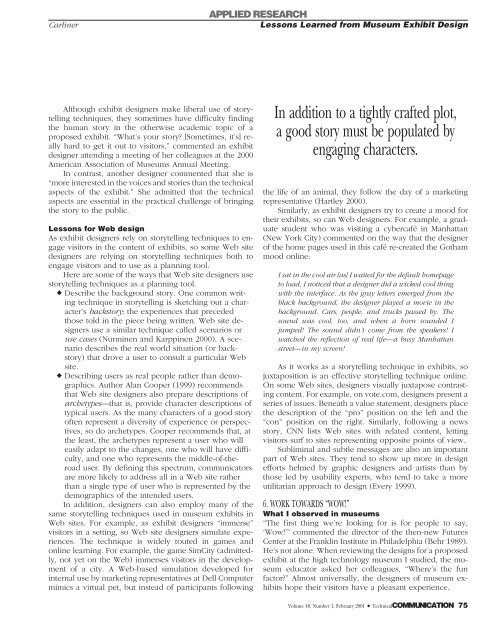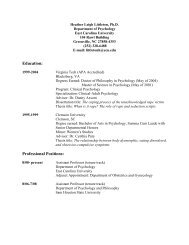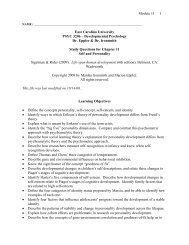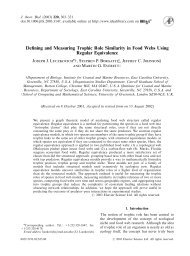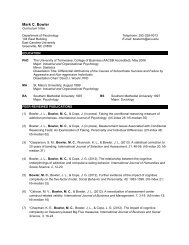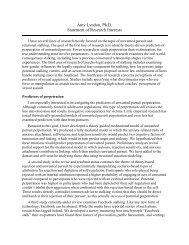Modeling Information for Three-Dimensional Space - Ecu
Modeling Information for Three-Dimensional Space - Ecu
Modeling Information for Three-Dimensional Space - Ecu
You also want an ePaper? Increase the reach of your titles
YUMPU automatically turns print PDFs into web optimized ePapers that Google loves.
Carliner<br />
APPLIED RESEARCH<br />
Lessons Learned from Museum Exhibit Design<br />
Although exhibit designers make liberal use of storytelling<br />
techniques, they sometimes have difficulty finding<br />
the human story in the otherwise academic topic of a<br />
proposed exhibit. “What’s your story [Sometimes, it’s] really<br />
hard to get it out to visitors,” commented an exhibit<br />
designer attending a meeting of her colleagues at the 2000<br />
American Association of Museums Annual Meeting.<br />
In contrast, another designer commented that she is<br />
“more interested in the voices and stories than the technical<br />
aspects of the exhibit.” She admitted that the technical<br />
aspects are essential in the practical challenge of bringing<br />
the story to the public.<br />
Lessons <strong>for</strong> Web design<br />
As exhibit designers rely on storytelling techniques to engage<br />
visitors in the content of exhibits, so some Web site<br />
designers are relying on storytelling techniques both to<br />
engage visitors and to use as a planning tool.<br />
Here are some of the ways that Web site designers use<br />
storytelling techniques as a planning tool.<br />
Describe the background story. One common writing<br />
technique in storytelling is sketching out a character’s<br />
backstory: the experiences that preceded<br />
those told in the piece being written. Web site designers<br />
use a similar technique called scenarios or<br />
use cases (Nurminen and Karppinen 2000). A scenario<br />
describes the real world situation (or backstory)<br />
that drove a user to consult a particular Web<br />
site.<br />
Describing users as real people rather than demographics.<br />
Author Alan Cooper (1999) recommends<br />
that Web site designers also prepare descriptions of<br />
archetypes—that is, provide character descriptions of<br />
typical users. As the many characters of a good story<br />
often represent a diversity of experience or perspectives,<br />
so do archetypes. Cooper recommends that, at<br />
the least, the archetypes represent a user who will<br />
easily adapt to the changes, one who will have difficulty,<br />
and one who represents the middle-of-theroad<br />
user. By defining this spectrum, communicators<br />
are more likely to address all in a Web site rather<br />
than a single type of user who is represented by the<br />
demographics of the intended users.<br />
In addition, designers can also employ many of the<br />
same storytelling techniques used in museum exhibits in<br />
Web sites. For example, as exhibit designers “immerse”<br />
visitors in a setting, so Web site designers simulate experiences.<br />
The technique is widely touted in games and<br />
online learning. For example, the game SimCity (admittedly,<br />
not yet on the Web) immerses visitors in the development<br />
of a city. A Web-based simulation developed <strong>for</strong><br />
internal use by marketing representatives at Dell Computer<br />
mimics a virtual pet, but instead of participants following<br />
In addition to a tightly crafted plot,<br />
a good story must be populated by<br />
engaging characters.<br />
the life of an animal, they follow the day of a marketing<br />
representative (Hartley 2000).<br />
Similarly, as exhibit designers try to create a mood <strong>for</strong><br />
their exhibits, so can Web designers. For example, a graduate<br />
student who was visiting a cybercafé in Manhattan<br />
(New York City) commented on the way that the designer<br />
of the home pages used in this café re-created the Gotham<br />
mood online:<br />
I sat in the cool air [as] I waited <strong>for</strong> the default homepage<br />
to load, I noticed that a designer did a wicked cool thing<br />
with the interface. As the gray letters emerged from the<br />
black background, the designer played a movie in the<br />
background. Cars, people, and trucks passed by. The<br />
sound was cool, too, and when a horn sounded I<br />
jumped! The sound didn’t come from the speakers! I<br />
watched the reflection of real life—a busy Manhattan<br />
street—in my screen!<br />
As it works as a storytelling technique in exhibits, so<br />
juxtaposition is an effective storytelling technique online.<br />
On some Web sites, designers visually juxtapose contrasting<br />
content. For example, on vote.com, designers present a<br />
series of issues. Beneath a value statement, designers place<br />
the description of the “pro” position on the left and the<br />
“con” position on the right. Similarly, following a news<br />
story, CNN lists Web sites with related content, letting<br />
visitors surf to sites representing opposite points of view.<br />
Subliminal and subtle messages are also an important<br />
part of Web sites. They tend to show up more in design<br />
ef<strong>for</strong>ts helmed by graphic designers and artists than by<br />
those led by usability experts, who tend to take a more<br />
utilitarian approach to design (Every 1999).<br />
6. WORK TOWARDS “WOW!”<br />
What I observed in museums<br />
“The first thing we’re looking <strong>for</strong> is <strong>for</strong> people to say,<br />
‘Wow!’” commented the director of the then-new Futures<br />
Center at the Franklin Institute in Philadelphia (Behr 1989).<br />
He’s not alone. When reviewing the designs <strong>for</strong> a proposed<br />
exhibit at the high technology museum I studied, the museum<br />
educator asked her colleagues, “Where’s the fun<br />
factor” Almost universally, the designers of museum exhibits<br />
hope their visitors have a pleasant experience.<br />
Volume 48, Number 1, February 2001 • TechnicalCOMMUNICATION 75


